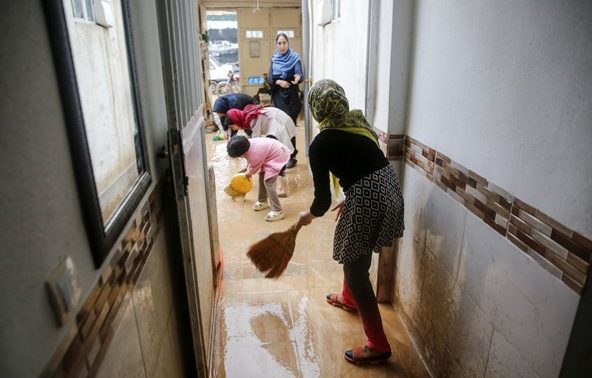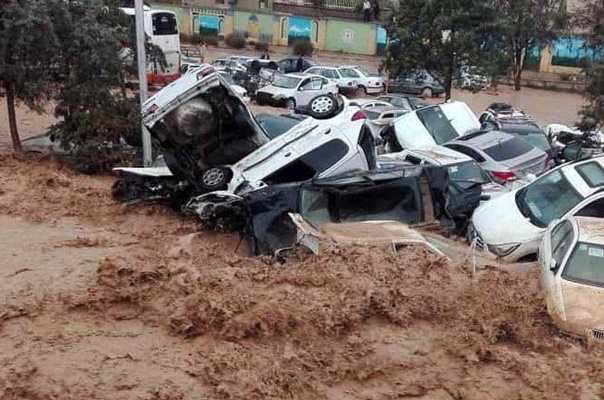April 19, 2019

A month of heavy rainfall has caused flooding in much of Iran, killing 76 people so far, and leaving thousands of homes with mud carpeting their floors—but the massive rains have not ended the country’s decade-long drought.
The government said that 725 bridges have been washed away by the rushing waters, a fact that will likely inhibit reconstruction and cause tribulations for communities for years to come.
One-third of the dead came in Shiraz where a flash flood surged down a major boulevard, pushing dozens of cars into a crumpled mass. The damage in Shiraz was confined almost entirely to that single thoroughfare and the flash flood lasted only about 10 minutes.

Locals said the roadway had been built over a riverbed that is ordinarily dry. It was clear that the designers failed to provide sufficient drainage. Thus, the roadway in effect became a giant sluiceway that funneled the water at great speed, tumbling cars like so many toys and killing many occupants.
Video taken by local residents showed a stunning drama with cars being pushed at high speed by the raging waters. In the case of two cars, men could be seen clinging to the rooftops as their cars sailed to their destruction. The videos were so dramatic that they made many television news shows around the world and brought the fact of what was happening in Iran to broad attention.
Accuweather reported that Shiraz got 75 millimeters (3 inches) of rain in just 36 hours, while normal rainfall for the entire month of March is less than 50 millimeters (2 inches).
To the northwest of Shiraz, Yasuj reported receiving almost 200 millimeters (8 inches) of rain in just two days.
There were other flash floods around the country, mainly in the southwest and in the north where rains collected in the mountains and surged down into the populated areas below. Energy Minister Reza Arda-kanian said 23 of Iran’s 31 provinces had been hit by flash floods. But most of the people impacted were instead subjected to rivers overflowing their banks and slowly inundating communities along the rivers, the flood waters carrying mud right into people’s homes.
The flooding began March 19 in Khorasan North, Golestan and Mazandaran provinces north of the Alborz Mountains and Semnan south of the mountain range. But after a month, the danger is not over. More heavy rains are anticipated. Furthermore, the government says the snowpack in the Alborz and Zagros Mountains this year is 20 percent greater than last year and will soon melt and pour into the valleys.
But Energy Minister Ardakanian said 76 percent of the reservoirs behind Iran’s dams—reservoirs that were dramatically low just weeks ago—are now full to the brim. No dam has collapsed, but the authorities are clearly worried. Officials have ordered a number of communities along the Dez and Karkheh Rivers to evacuate, saying the water flowing into dam reservoirs there will have to be released because the reservoirs can hold no more.
Ardakanian said the flooding was the worst the country has seen in more than half a century.
Iraq has also been badly hit by flooding, with at least 10 deaths. But Iran’s ambassador to Iraq confirmed that hundreds of militiamen belonging to groups founded with Iranian money have entered Iran to help with flood relief. That did not go over well with many Iranians.
Iranian officials attributed the severity of the weather to climate change. The immediate cause was a low pressure system parked over northern Pakistan since just before Now Ruz that kept rainstorms pinioned over Iraq and Iran.
Water specialists were quick to warn the public that all this rain does not mean that the drought has ended and that they can resume using water as they wish. They pointed out that a major problem facing Iran is the large number of underground water aquifers that have been drained. They said little of the recent rainfall will ever reach the aquifers to recharge them but will instead evaporate or run off through rivers to the sea.
As of April 14, the Forensic Medicine Organization said it had recorded 76 deaths, with more likely to be recorded later. Six of the dead were reported from Golestan province when a boat full rescuers and rescued residents overturned.
Ardakanian said that the first 15 days of the new year saw average rainfall across the country reach 57 millimeters, which was 19 times the rainfall in the same period last year.
There are a few benefits from the rain. Many of Iran’s marshes are now resuscitated, meaning that they will not produce the sandstorms that have plagued the country in recent years. One of those newly-wet areas is the Howizeh marches along the border with Iraq; just a few months ago, they were so dry that they were on fire on the Iraqi side for weeks. How long the wetness will last remains to be seen, however. Also, with reservoirs so low before this, electricity production had dropped. But with reservoirs now full, electricity output has surged.
Much of the news coverage in Iran has focused on the military’s efforts to help out, but many complain that this is more propaganda than actual help. In many communities, flooded-out residents complain to reporters that they have received no help from either the military or the Red Crescent Society. One problem is that the floods began just before Now Ruz, with many people on vacation.
A Red Crescent official told Agence France Presse the agency was overwhelmed by the scale of the disaster and could not help everywhere it was needed. He said aid workers were prioritizing locales and ignoring many where the damage was more limited. The regime said that as of April 14 it was providing emergency shelters for 220,000 people, whole orders of magnitude than those it routinely shelters after a major earthquake.
Officials also used the flooding as a whip to attack the United States, saying that US sanctions prevented any aid from reaching Iran. When 12 countries provided relief aid, the story changed that the US sanctions prevented any cash from being given to Iran. But the Vatican said it had sent 100,000 euros to Tehran for the papal nuncio in Tehran to distribute. And South Korea announced it had handed over $200,000. US sanctions specifically exempt cash humanitarian aid. Iranian officials did not mention that many international charities do not trust the Iranian regime with cash and prefer to provide specific aid like tents, blankets and food. The EU was promoting aid-in-kind, not cash aid.
Interior Minister Abdol-Reza Rahmani-Fazli told the Majlis the flooding has so far caused damage amounting to 300 trillion to 350 trillion rials—$2.3 billion to $2.6 billion at the current rate of exchange. While many questioned the regime’s ability to get an accurate assessment, the fact is the losses are high and the regime will face a major problem rebuilding when its budget is already severely strained by the revenue loss caused by the US sanctions on oil sales.
The government has said it will pay compensation to all citizens who have incurred losses, raising the bill substantially. Supreme Leader Ali Khamenehi announced that the government would be allowed to tap the state’s sovereign wealth fund, which officially contains $92 billion. President Rohani had asked to take $2 billion from that source.
As always after such disasters, there was a quick effort to assign blame, with Rohani’s opponents saying he hadn’t done enough to prevent the disaster or to provide speedy relief. In the case of the flash flood in Shiraz, there appears to be good reason to hold government engineers responsible.
But a few voices questioned the rush to blame. Prof. Eddy Moors, rector of the IHE Delft Institute for Water Education, told Radio Zamaneh that in extreme cases like this year’s flooding, “It is rather difficult to take the measures necessary to prevent damage to infrastructure and loss of life.” Some even commented that the loss of 76 lives was not unreasonable considering the extent of the flooding.
Ahmad-Reza Djalali, a disaster relief specialist who is a dual Swedish-Iranian national and is now imprisoned, said in a telephone interview that Iran’s preparations have always focused on earthquakes, not floods, and workers were not equipped by training or with the right equipment to handle the current emergency. Floods demand people with boats, which are irrelevant after a quake.
Meanwhile, the Oil Ministry shut down some oil wells, piled sandbags around them, and emptied out a number of pipelines as flood waters rose in Khuzestan province. It did not say how much production was reduced by the measures. But considering that Iran is now storing vast amounts of crude because it cannot sell it all, the shutting down of wells would not appear likely to cause Iran any economic loss.
An assessment of possible damage to ancient sites remains to be done. However, a waterfall opened up at the top of Naqsh-e Rustam, site of the tombs of four rulers of the Achaemenid Dynasty, and officials said cracks had been noted in some of the reliefs carved into that mountainside. A video taken March 25 showed a new waterfall, albeit very narrow, pouring water from the top of the site to the valley floor between the third and fourth tombs.
Officials at Persepolis, where a project over the last two years cleaned out 2,500-year-old drainage paths, reported that Persepolis had suffered no damage so far.
At nearby Pasargadae, site of the tomb of Cyrus the Great, flood waters inundated much of the vast field in which the tomb is located, but did not reach the tomb itself, according to photos from the site.
However, the Islamic Republic News Agency (IRNA) reported damage to the historic wall north of Gorgan that was built in the Sassanian Dynasty (224-651 CE) to keep out invaders from Central Asia.
Tehran received considerable rain but reported no more than local flooding.






















